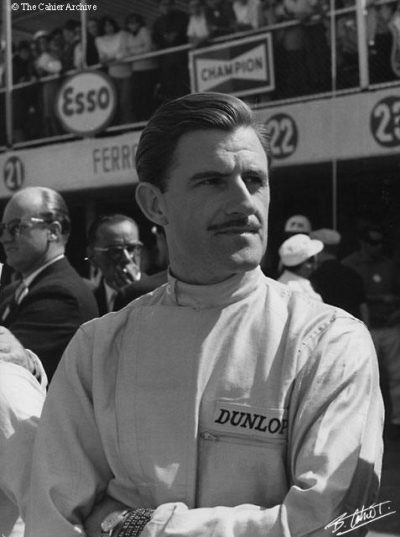Graham Hill (Norman Graham Hill)

Graham Hill did not pass his driving test until he was 24 years old, and he himself described his first car as “A wreck. A budding racing driver should own such a car, as it teaches delicacy, poise and anticipation, mostly the latter I think!”[citation needed] He had been interested in motorcycles but in 1954 he saw an advertisement for the Universal Motor Racing Club at Brands Hatch offering laps for 5 shillings. He made his debut in a Cooper 500 Formula 3 car and was committed to racing thereafter. Hill joined Team Lotus as a mechanic soon after but quickly talked his way into the cockpit. The Lotus presence in Formula One allowed him to make his debut at the 1958 Monaco Grand Prix, retiring with a halfshaft failure. In 1960, Hill joined BRM, and won the world championship with them in 1962. Hill was also part of the so-called ‘British invasion’ of drivers and cars in the Indianapolis 500 during the mid-1960s, triumphing there in 1966 in a Lola-Ford. In 1967, back at Lotus, Graham Hill helped to develop the Lotus 49 with the new Cosworth-V8 engine. After team mates Jim Clark and Mike Spence were killed in early 1968, Hill led the team, and won his second world championship in 1968. The Lotus had a reputation of being very fragile and dangerous at that time, especially with the new aerodynamic aids which caused similar crashes of Hill and Jochen Rindt at the 1969 Spanish Grand Prix. A crash at the 1969 United States Grand Prix at Watkins Glen broke both his legs and interrupted his career. Typically, when asked soon after the crash if he wanted to pass on a message to his wife, Hill replied “Just tell her that I won’t be dancing for two weeks.”
Upon recovery Graham Hill continued to race in F1 for several more years, but never again with the same level of success. Colin Chapman, believing Hill was a spent force, placed him in Rob Walker’s team for 1970, sweetening the deal with one of the brand-new Lotus 72 cars. Although Hill scored points in 1970 he started the season far from fully fit and the 72 was not fully developed until late in the season. Hill moved to Brabham for 1971-2; his last win in Formula One was in the non-Championship International Trophy at Silverstone in 1971 with the “lobster claw” Brabham. The team was in flux after the retirements of Sir Jack Brabham and then Ron Tauranac’s sale to Bernie Ecclestone; Hill did not settle there. Graham Hill was known during the latter part of his career for his wit and became a popular personality – he was a regular guest on television and wrote a notably frank and witty autobiography, Life at the Limit, when recovering from his 1969 accident. Hill was also irreverently immortalized on a Monty Python episode (“It’s the Arts (or: Intermission)” sketch called “Historical Impersonations”), in which a Gumby appears asking to “see John the Baptist’s impersonation of Graham Hill.” The head of St. John the Baptist appears (with a stuck-on moustache in Hill’s style) on a silver platter, which runs around the floor making putt-putt noises of a race car engine.
Graham Hill was involved with four films between 1966 and 1974, including appearances in Grand Prix and Caravan to Vaccarès, in which he appeared as a helicopter pilot. Although Hill had concentrated on F1 he also maintained a presence in sports car racing throughout his career (including two runs in the Rover-BRM gas turbine car at Le Mans). As his F1 career drew to a close he became part of the Matra sports car team, taking a victory in the 1972 24 Hours of Le Mans with Henri Pescarolo. This victory completed the so-called Triple Crown of motorsport which is alternatively defined as winning either: the Indianapolis 500 (won by Hill in 1966), the 24 Hours of Le Mans (1972) and the Monaco Grand Prix (1963–65, 1968, 1969), or the Indianapolis 500, the 24 Hours of Le Mans and the Formula One World Championship (1962, 1968). Using either definition, Hill is still the only person ever to have accomplished this feat. Hill set up his own team in 1973: Embassy Hill with sponsorship from Imperial Tobacco. The team used chassis from Shadow and Lola before evolving the Lola into its own design in 1975. After failing to qualify for the 1975 Monaco Grand Prix, where he had won five times, Hill retired from driving to concentrate on running the team and supporting his protege Tony Brise. Hill’s record of 176 Grand Prix starts remained in place for over a decade until being equalled by Jacques Laffite. On November 29, 1975 returning from the Paul Ricard circuit, France, Hill was killed when the Piper PA 23-250 Turbo-Aztec that he was piloting (not registered, but displaying its previous cancelled US registration N6645Y) crashed near Arkley golf course in London, while attempting to land at Elstree Airfield at night in heavy fog.
Born
- February, 15, 1929
- United Kingdom
- Hampstead, Greater London, England
Died
- November, 29, 1975
- United Kingdom
- Arkley, Greater London, England
Cause of Death
- plane crash
Cemetery
- Saint Bololph's Churchyard
- Shenley, Hertsmere Borough, Hertfordshire, England
- United Kingdom



